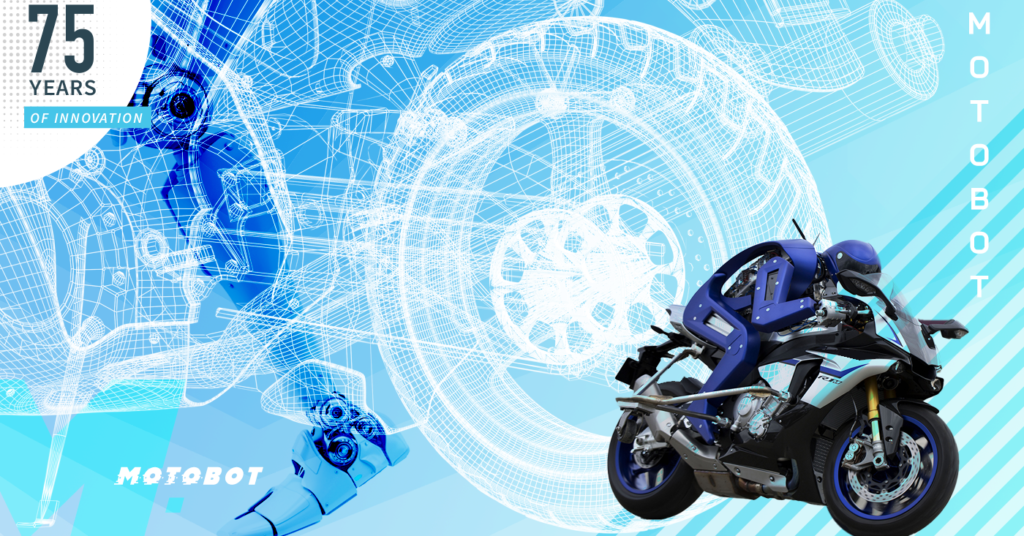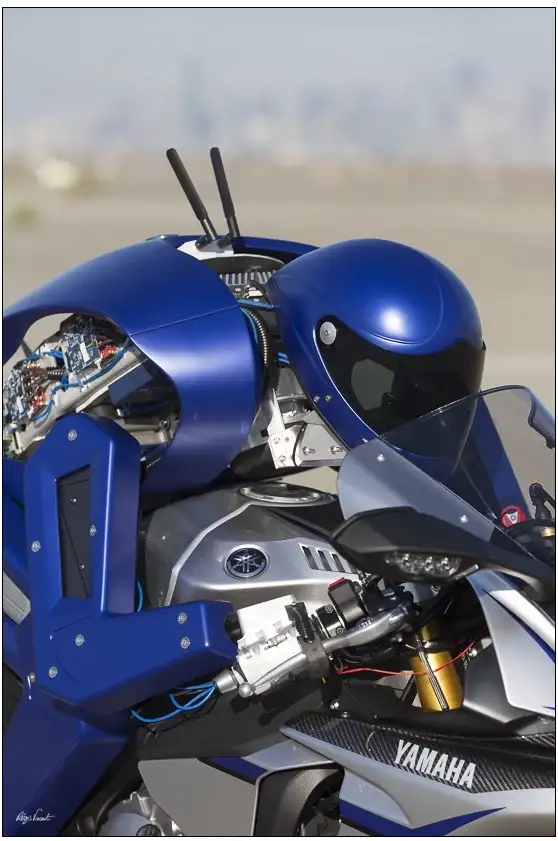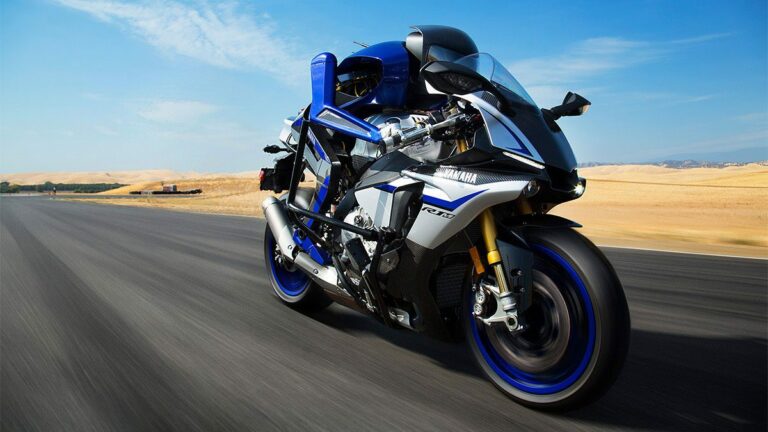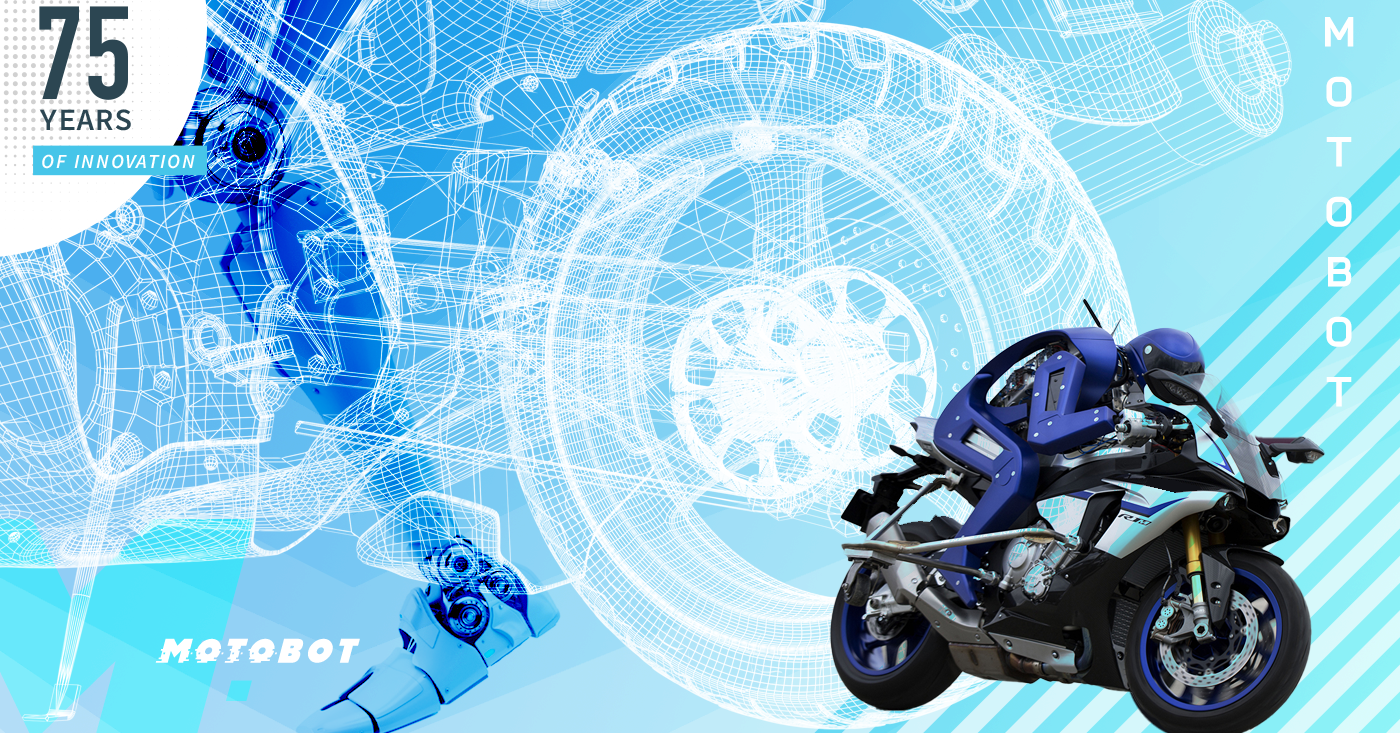The first autonomous motorcycle-riding humanoid robot
The 75 Years of Innovation series highlights the groundbreaking innovations spanning from SRI’s founding in 1946 to today. Each week, SRI will release an innovation, leading up to its 75th anniversary in November 2021.

What looks like a human, rides like a human, but Is not a Human? It’s Motobot!
Anyone who has been on a motorbike knows how thrilling it is. But we all need security and protection. When SRI was tasked by Yamaha to create a safer riding experience, they went full tilt at the job. Working alongside Yamaha engineers, SRI International developed the world’s first autonomous motorcycle-riding humanoid robot, named MOTOBOT.
MOTOBOT rides an unmodified Yamaha YZF-R1M bike; from a distance MOTOBOT is indistinguishable from a human rider. This is how MOTOBOT drove into our lives to help make riding motorcycles safer and even more fun.
MOTOBOT takes a ride
The Yamaha YZF-R1M is a very fast motorbike; known as a ‘Superbike’, it has a top speed of 183+ mph. This Superbike is used as both a racing motorcycle by professionals and as a top-notch bike for enthusiasts.
Fast motorbikes need to withstand precision testing to ensure rider safety and to help in perfecting their design. But using human riders to test high-performance motorcycles can be risky. Yamaha Motor Ventures needed a smart ‘crash test dummy’ designed for motorcycle test conditions. The design remit was to create a human-like rider; a robotic motorcyclist that could ride like a human, putting an unmodified Yamaha YZF-R1M under test conditions that mimicked a human experience. In doing so, the robot could help in future design and safety. As a competition bike, the results of such tests could provide optimization data to improve bike performance so that it could achieve record lap times at the circuit.
MOTOBOT, the first autonomous motorcycle-riding humanoid robot, was born out of this collaboration between the teams at Yamaha and SRI International.

The place of MOTOBOT in the history of technology
MOTOBOT is smart, really smart. MOTOBOT has to be able to work intelligently to simulate the myriad variables and conditions of a human rider. Many events happen during a ride and MOTOBOT has to be able to instantaneously react to these ever-changing variables. To create MOTOBOT, the collaboration between Yamaha and SRI International split the tasks into two main areas:

Yamaha: Designed the algorithms for high speed motorcycle riding used in the analysis of vehicle dynamics. They were also behind in the reliability design of electronics.
SRI: SRI has the robotics expertise needed to develop MOTOBOT to Yamaha requirements. SRI also developed the high-precision position sensing system needed to guide MOTOBOT down circuit pathways.
SRI and Yamaha perfected MOTOBOT between versions. Where version 1 was more prototype-like with an aluminum shell that caused design constraints, version 2 took MOTOBOT to new levels of optimization. MOTOBOT 2 used lighter weight carbon fibers for the body. This allowed the designers to free-up space inside MOTOBOT to refine the internal layout. The robot includes six actuators that are required for riding that control the steering, throttle, front brake, rear brake, clutch, and gear shift.
The redesign meant motor controllers could be placed closer to the actuators, thus reducing noise and improving performance. MOTOBOT 2 was designed to be faster and more precise. To be effective under real ride conditions, MOTOBOT needed to be able to learn how to navigate track pathways with precision and make decisions at speed. Machine learning, high-precision GPS, and sensors, all play a part in making sure MOTOBOT takes the right road.
MOTOBOT is part of a revolution in robotics and vehicle autonomy. The lessons learned as MOTOBOT becomes more precise and able to increasingly utilize machine learning will no doubt offer insight into autonomous vehicle design going forward.

How an autonomous motorcycle-Riding Humanoid Made Motorcycling Safer
One of the original goals of the MOTOBOT team was to develop an autonomous rider that could beat MotoGP world champion Valentino Rossi. This would prove MOTOBOT could truly replicate a human rider, even to the extreme. In 2017, MOTOBOT took on Rossi but was pipped at the post by its human counterpart. But one thing that MOTOBOT has is the ability to learn. MOTOBOT, like the rest of us, learns by its mistakes. MOTOBOT will continue to improve on its game, ensuring it turns at the right point and takes the optimal path, including a path to safer motorbike design.
As Thomas P. Low, former Associate Director of Robotics at SRI said at the launch of MOTOBOT:
“We will demonstrate how far humanoid robots have advanced in efficiency and performance and how industry leaders such as Yamaha Motor can leverage robotics to solve business challenges, create competitive advantages and accelerate innovation”
In the next challenge, MOTOBOT will beat the clock and make motorbikes safer and even more exciting to ride.
Resources
World Health Organization (WHO), 2018 Global Status Report on Road Safety: https://www.who.int/violence_injury_prevention/road_safety_status/2018/GSRRS2018_Summary_EN.pdf
Videos showing MOTOBOT in action: https://global.yamaha-motor.com/showroom/motobot/
Video, The Story Behind the MOTOBOT Project: https://www.youtube.com/watch?v=YSf5xBY-AoM
SRI Robotics: https://www.sri.com/robotics-sensors-devices/
Press release, Yamaha Motor and SRI International Announce Collaboration on the Development of a Motorcycle-Riding Humanoid Robot (MOTOBOT) at CES 2016: https://www.prnewswire.com/news-releases/yamaha-motor-and-sri-international-announce-collaboration-on-the-development-of-a-motorcycle-riding-humanoid-robot-motobot-at-ces-2016-300200752.html



